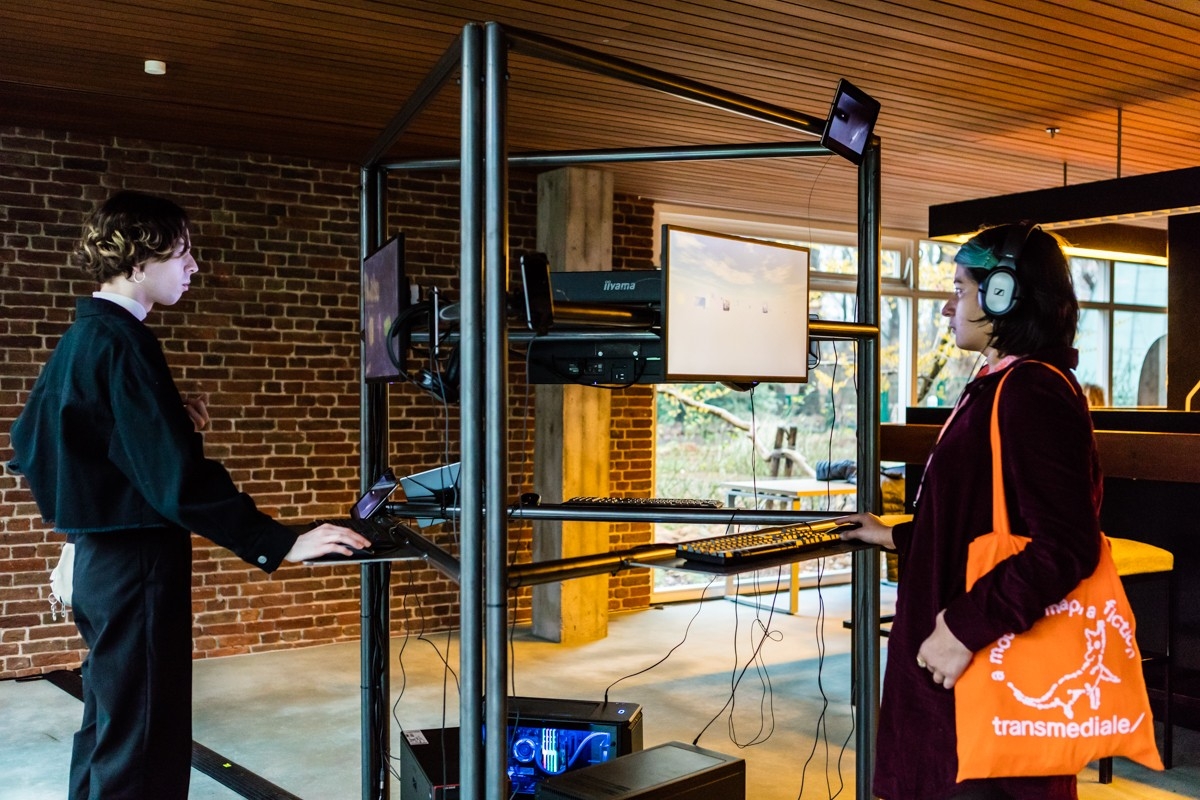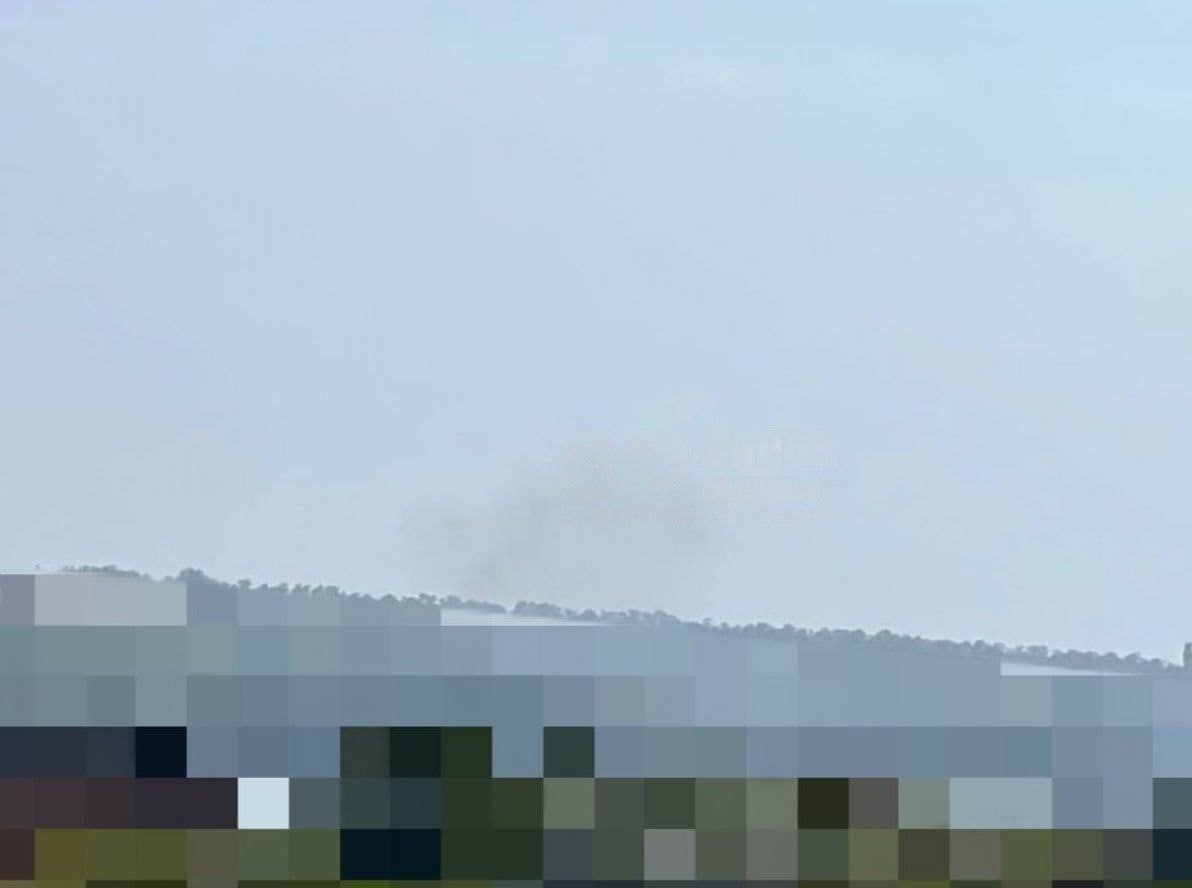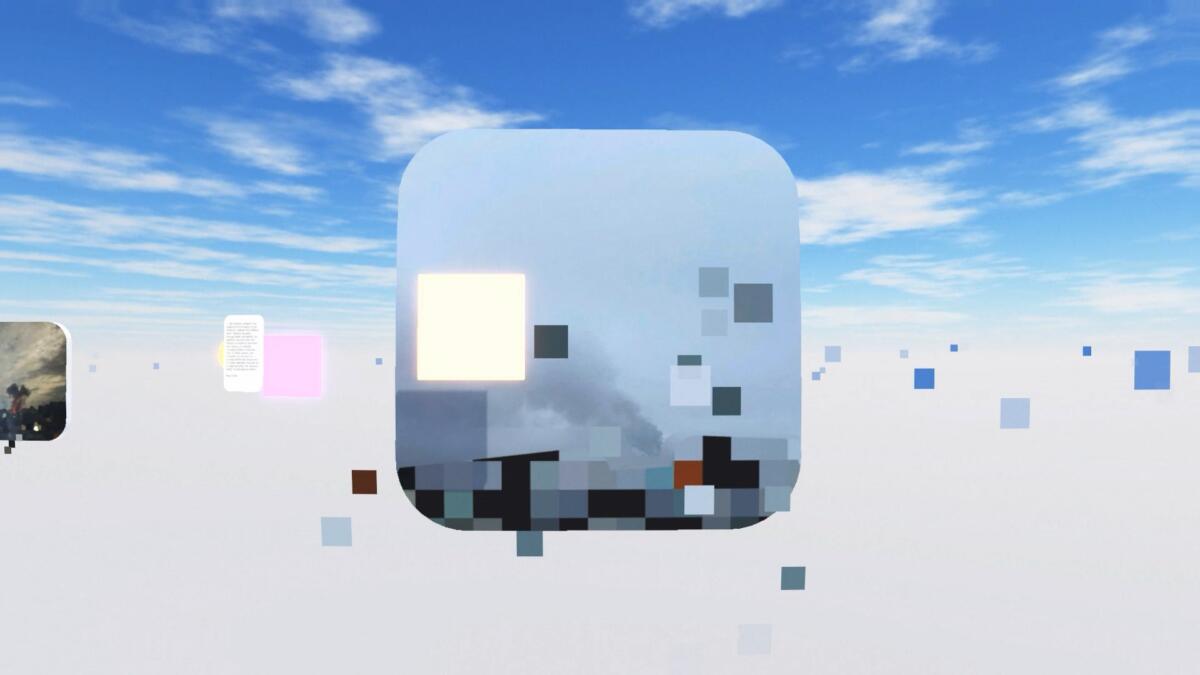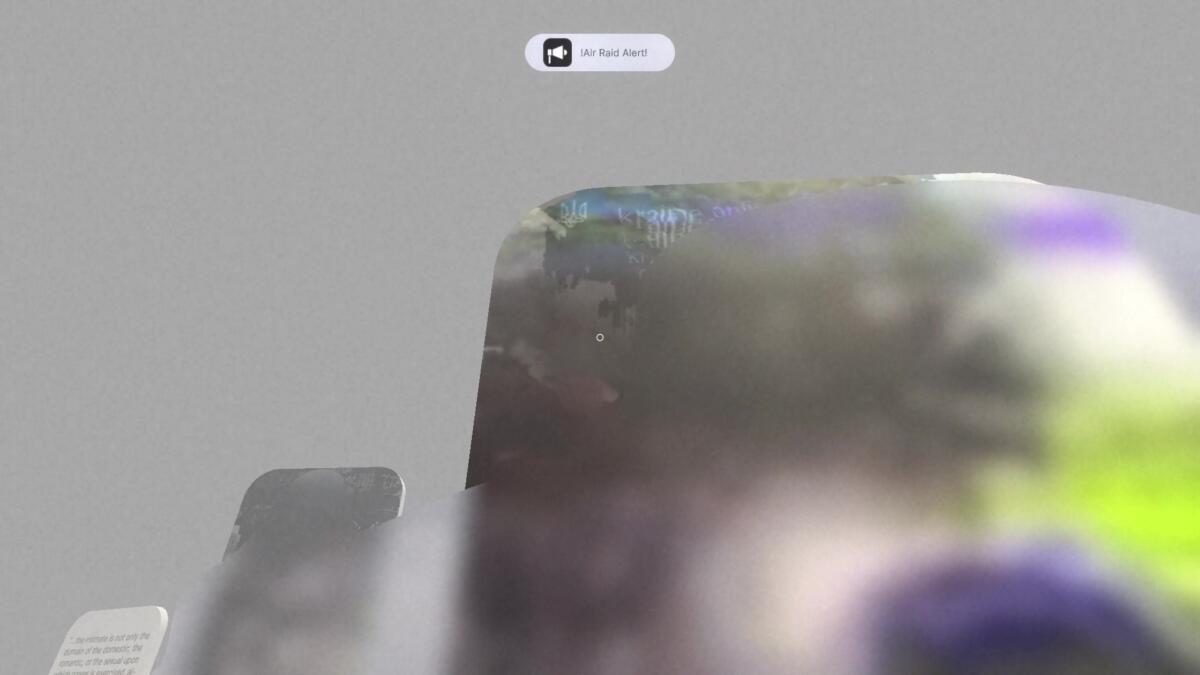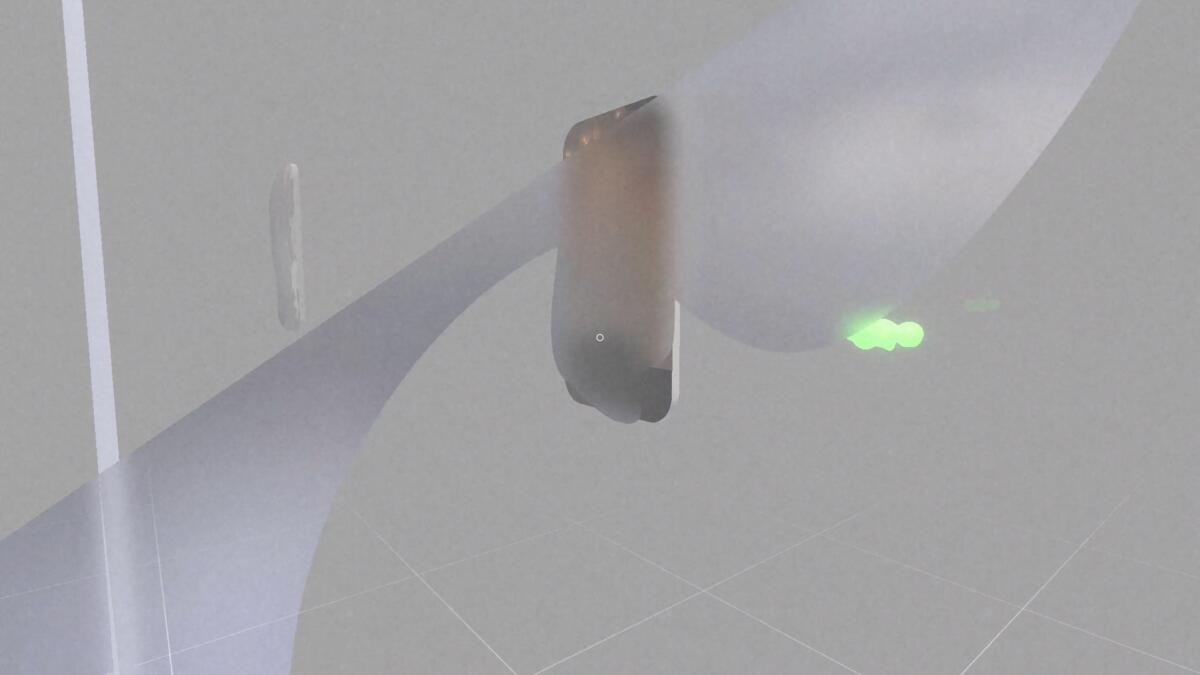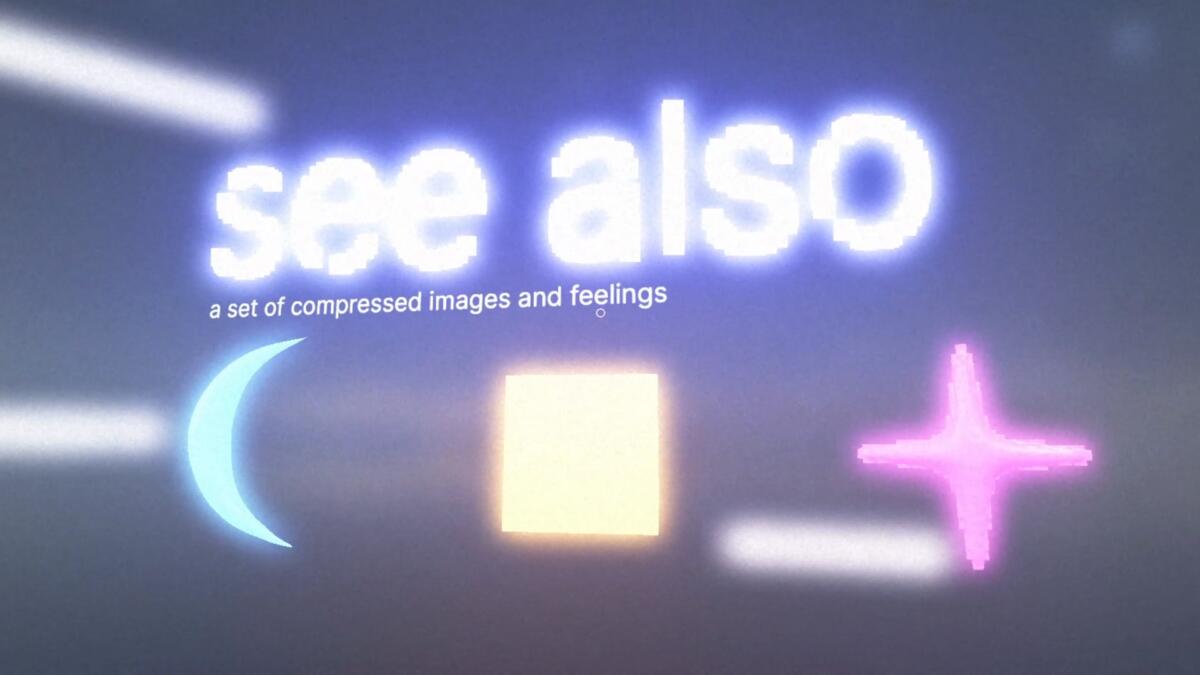
fantastic little splash is a Ukrainian-based collective comprising journalist/artist Lera Malchenko and artist/director Oleksandr Hants. The collective combines art practice and media studies, and is interested in utopias, dystopias, the collective imagination and its incarnations, projections, delusions, and uncertainties. Established in 2016, their projects have been exhibited at transmediale, post.MoMA, Plokta TV, Ars Electronica, Liste Art Fair Basel, Construction festival VI x CYNETART, KISFF, and Docudays, among others. In 2022 they participated in the transmediale x Pro Helvetia Residency 2022.
I first met fantastic little splash when they were participating in the “Bodies as Lands – Sociotechnical Imaginaries and Spatial Arrangements in Eastern Europe” residency programme at Nida Art Colony of the Vilnius Academy of Arts. During the presentation, I learned about their recent work see also, and later got a chance to see it at the “If Disrupted, It Becomes Tangible” exhibition at the National Gallery of Art in Vilnius. Deeply touched by this work, I was very grateful for the opportunity to chat with Lera and Sasha over a Zoom call, and to dive deeper into the artwork and the questions it explores. The conversation took place in June 2023.
Yana: For those who haven’t seen the work, could you please briefly share what see also is about?
Sasha: see also is a project about the images of war, specifically images of Russia’s war against Ukraine. Since nowadays almost all images we consume are digital, we chose to focus specifically on them and on the emotions these images evoke.
Lera: We usually think about this project and introduce it as an interactive archive of distorted images and feelings. One of its characteristics is that all images are either blurred, compressed, or pixelated. For that we collected some found footage from Ukrainian Telegram channels and social media. And while working with them, we are trying to understand and reveal what effects social media and various messaging platforms and apps have on our emotions under cyberwar. By cyberwar, we mean the use of emerging technologies for military operations that are organized in parallel to actual combat on the battlefield. Such military operations can include both hacking attacks on digital infrastructures and informational operations through social networks and messengers. These operations can be used against the entire population, both military and civilian. Rather, it is the effects on civilians that we are most interested in, particularly in see also.
Technically see also works as an installation with a few PCs and screens for interactive files and videos. Some videos document the archive, others are just additional videos and image interpretations which were made during the research process.
But now, having the opportunity to think about this work from some distance, as we finished it back in February, I feel that this project is also about further developing our method of artistic research. Figuring out how to live with different emotions and really feel them, but at the same time learning to build emotional awareness. As all of us are now subjects of cyberwar, there is an urgent need for some kind of contemporary mindfulness. Not in fancy, esoteric terms that are often used these days; instead we are talking about the need to be conscious with our gadgets, our newsfeeds, and our social media accounts. see also is one of the many works we made that attempts to develop our own method for exploring these questions.
Was this attempt to develop a new method the main reason to work with a simulation format? Most of your previous projects were video works, but see also is an interactive simulation.
Sasha: Some of our earlier works also included interactive elements. Our first big project, xoax, consisted of many smaller works, including a computer simulation that people could interact with. Later we had another work, forward, upward, in all directions, where people could interact with physical objects while they were watching the other part of the project, which is the documentary video. But see also is our first interactive work that is entirely an interactive simulation.
Before the full-scale invasion we had already been thinking about the project related to social networks, but the actual research began in 2022 during the residency at transmediale x Pro Helvetia. But the idea was very different although it had an interactive aspect. Lera went to Berlin for two weeks for this residency, and for some time we were thinking about the work separately. When she came back, we both felt that it should be a kind of interaction where the viewer would have more control, the agency to engage with the work.
Lera: It seems to me therefore that see also developed quite naturally from our practice. Our collective started in 2016, among other things, as a reaction to the beginning of the war in Ukraine and the role of the media on it. Our very first exhibition, xoax, in Kyiv, was about that. That time we were trying to find different, less manipulative forms of engagement for contemporary viewers. We first worked with a more conventional documentary – with a narrator, a problem of some sort, etc. – but figured that it wasn’t our format. With each new project we did, we were searching for methods to communicate with viewers on the same level, without all these deductive narration methods. It turned into a kind of obsession – thinking how to impact the viewer less and how to not push them into rigid frames.
We believe that the format of see also felt right for the topic of war images, distorted thoughts and emotions. We wanted the viewer to be able to leave the scene if it is too difficult for them to watch. It wasn’t our goal to produce suffering for anyone interacting with the images. We wanted to provide space for people to walk through the images and videos, having the option to decide if they wanted to look at them or not. There are no obligatory steps you have to take in this simulation. The only thing that you can’t turn off is the narration – it automatically starts playing as soon as you start exploring the environment. However, you can leave the space any time, you don’t have to listen to the entire narration to do this.
And in the gallery you have a simulation but you can also choose to watch a video piece. With this decision I assume you were also intending to give the viewers more freedom to experience the work.
Lera: Yes, not everyone wants to interact with a simulation. And we learned from the first exhibition in Berlin that not every person can do that; you need some practice in this kind of media to engage with it. And it’s not a commercial piece with an obvious scenario, so you can also get stuck in some parts. For those people who don’t feel comfortable with this format, they can watch the video instead.
One of the very personal attachments I had with your work was through the images of my hometown that is now under Russian occupation. I had a strange feeling looking at the image, a map of the region where I grew up, pixelated, it has become a center of global attention since the full scale invasion, and even more so after yesterday [the destruction of the Kakhovka dam]. Do you remember how you moved from being an observer of these many images to deciding on making an art work about/with them?
Lera: For me, it came from this need to be conscious about the content we consume. As subjects of this war we constantly go through difficult emotional states, and it became a regular practice for me to observe my feelings and reactions. We discussed it with Sasha, made notes, started collecting images and sending them to each other. This was probably where the work began, a continuation of our regular everyday practice of interacting with the content. Sasha, do you remember how these observations turned into a project?
Sasha: There was no specific point in time. I think it emerged from personal research, as you mentioned, of what we saw…
Lera: It was like journaling.
Sasha: We collected images from Telegram and started seeing connections and patterns specific to war images. It was especially stunning to see photos taken by ordinary people, not by media workers, not by the military, not by professional documentary photographers. These optics do not have any professional standards, rules, or artistic methods of creation. Just raw images, minimally “moderated” by the very people who made them. They were immediate – somebody took a picture, posted it, and you would see it right away. The speed of this terror, without verifying images, was shocking, abrupt and was something we were totally unaccustomed to, if I may say.
Lera: The level of mediatisation of this war raises questions of what counts as evidence these days, what counts as an archive. These are painful questions. While collecting these images, we also tried to create an archive of this war, however not in its traditional meaning. For us it was clear that this type of archive cannot just consist of a set of images. You can’t draw a clear distinction between the visuals and the individual and collective emotional processes. So we thought this could be a starting point, to have this temporary archive as a set of compressed images and feelings glued together.
Sasha: I remember how at the beginning of the full-scale invasion many people posted photos of the sky with a rooftop and rocket trails in the background. Since our government asked not to share such images because of the army’s needs, people started sharing blurry and pixelated visuals. We spoke with Lera about it quite often, how strange it was. You see a photo from your town, for example, but you don’t know whether it’s your house or somebody else’s. You are constantly trying to figure out what district it is, where the place is. You see that something happened, but you can’t recognise exactly what and where. It adds an additional level of uncertainty to the entire situation.
It makes me think how for many of us who fled to another region or abroad, these distorted images are often the first connection points with our homes. Earlier we had a discussion about solidarity networks in times of war, which I feel is quite relevant in this context. When something happens – such as a missile attack – the witnesses take photos and publish them on social media with some sort of distortion. Then through private chats the conversations continue as those far away try to find more information, get in touch with family members through other people, ask to check on their homes, etc.
Lera: Yes, but we think it’s important not just for the people who left their homes but for everyone really. Even if you don’t live in those Ukrainian cities that are under constant attack, you’re always in this amplified space – amplified by social media and other social networks. And if you live there, you get news from different cities in Ukraine that are all your home at this moment. In this case, the amplification of emotions and feelings is huge, and it distorts perception systems – human and non, that’s how we started thinking about distortion as a common state for everyone, and how everything can feel or be registered because all the sensors are overloaded.
Another part of the installation was a short video of actual and simulated digital artifacts of these collected war images. It also includes the poem Confusion by Federico Garcia Lorca from his “Suite of the Mirrors.” In the video, we tried to grasp this fusion of all the overloaded feeling systems to reveal this particular state of amplified collectivity.
“My heart – is it your heart?”, poem: Confusion (from Suite of the Mirrors) – Federico García Lorca,
translated by José Angel Araguz. Video: made by fantastic little splash for see also, 2023
You mentioned that the process of working on this project was quite natural. I am wondering if navigating through the different roles while working on see also was any different. Lera, you have a background in journalism and both of you are artists that have also had to take on many new roles and responsibilities personally and professionally that came with war.
Lera: For me it was an issue from the very beginning of this war, before the full-scale invasion, when Crimea, and the Donetsk and Luhansk regions were annexed. I worked as a news reporter back then. It was a very difficult job considering all the professional standards, for emotional evaluations, for instance. After leaving this work, I started filming documentaries for “Hromadske Dnipro” which allowed more space for subjectivity. And in 2016 we started fantastic little splash with Sasha. Maybe this is the answer to how I navigate this space – I left the news reporting when it didn’t feel right and started searching for other forms of expression. [Smiles.]
Nowadays I don’t work as this type of a journalist. If I write, these are usually longer texts, essays for example. I am mostly working as an OSINT (open-source intelligence) researcher, and in this role I am very much protected from many moral dilemmas. For the OSINT researcher metadata, legal and technical data are the main things that exist. For me it works well now. On the one hand, I am doing research following very strict rules and on the other hand, I am an artist with many opportunities to express my feelings and thoughts. And it’s interesting that in our common practice, all our backgrounds and methods mix. Our work is very multidisciplinary, which I feel is important for artist-researchers these days. The type of questions we deal with need research and methods that develop and coexist in between different sectors and disciplines.
And for you, Sasha?
Sasha: I think our work process was more or less the same as with the other projects. see also was definitely more emotional because the war has had a strong influence on us, but we always started with our emotions and experiences first and then moved into the research phase. It’s very important for us to introduce these personal experiences without creating sharp borders. We want the viewer to have room for their own interpretation. In this sense, working on this project followed the same process.
Lera: Maybe one short note in relation to the question of “subjectivity”, especially in the context of war. I think it’s very important to discuss it now because our subjectivity under cyberwar is greatly weaponized. There are many ongoing discussions that we [Ukrainians] are too emotional as observers or witnesses. I don’t think so. Cyberwar works in another way, and there is no opportunity to live through war without weaponizing your subjectivity, regardless whether you are in Ukraine or abroad. The only way to learn about this war and about us as society, as humans living through war, is by trying to understand how our emotions work in connection with our subjectivity. Perhaps these are no longer our emotions? They can be appropriated by states, organizations, and platforms. We have to do a lot of work to unpack all these processes.
It reminds me of the experience an acquaintance of mine had when making a presentation about the war at an international conference. With the words of support, they also received a comment about biased opinion influenced by their emotional attachment to the subject. It’s certainly a big challenge for many professionals in Ukraine now, especially those working in academia, journalism, as you already mentioned, or any other sector with sharp boundaries and frames. Emotions somehow should stay behind the closed doors.
Lera: Saying “don’t have such strong emotions” is certainly a privilege of being outside the war zone and outside the related informational environment. Moreover, this distance is about a lack of knowledge that makes it impossible to draw any objective conclusions. So I don’t even know how such a position can be considered possible for conclusion-making. Our emotional experiences are part of this war knowledge.
Sasha: I think of emotions as of our body’s physiological responses to a variety of triggers. They are part of our nature, we can’t deny or remove them somehow. They tell us a lot, including our needs and desires. It can be said that not feeling your emotions means detaching from yourself. And I think the important point is how you react and act in response to these emotions.
Lera: Nowadays with emerging media that engages us every minute and every second, staying aware of its impact on us becomes more and more challenging. Commercial strategies and algorithms on social media make it difficult to differentiate our real decisions from the ones enforced from the outside. And then it’s just a question of time when all of these commercial techniques become military techniques. This is what Svitlana Matvienko and Nick Dyer-Witheford wrote in their book “Cyberwar and Revolution” about “communicative militarism” and how it works – commercial platforms are merged with military technology and techniques of social engineering and psyops. As a media user, you can’t often understand what is going on. It seems to me, in Ukraine, we are now starting to develop the knowledge of how to live in these regimes of emotional extractivism. It’s happening because of the war. All the other people will have to ask these questions a bit later either because of expansion of the cyberwar or because of too intense effects of a new TikTok feature.
Just like the younger generation no longer responds to cold calls and other conventional sales techniques – they know how these methods work and therefore can better resist them. In the case of the war, constantly being surrounded by so many messages forces us to learn how to navigate through them.
But speaking about emotions and our reactions. When I first started interacting with your work at the gallery, I entered a scene with the fog background and was anxiously running around in search for the light or some indication of an image. But then you also have this beautiful blue sky background with the birds singing, the starry sky, and the neutral warm color space. Could you pull back the curtains a bit and talk about these diverse environments you have created?
Lera: We wanted to explore inner and outer spaces. For example, when you are in this scene with the blue sky, with the recording of birds singing in Uzhgorod…
Oh wow, I didn’t realize the recording was made in Ukraine.
Sasha: Most of the sounds were recorded in Uzhgorod, some were also computer-generated sounds. We wanted to use the real sounds from the war environment. Uzhgorod is the relatively safest place in Ukraine right now, and since Lera and I were there when working on this project, we documented our experience through this work.
Lera: Going back to the blue sky scene, for me in some way it reflects the gap you find yourself in after reading horrific news, after the attacks… You are shocked that the birds are still singing, the trees are still growing. This strange war experience, when your life becomes like a nightmare. It forms some kind of a shock of normal life. We felt it strongly and read the stories of many Ukraininans dealing with a similar experience.
And as to the other backgrounds – some focus more on the inner world and other on the outer, also on the mix of both. When you can’t figure out how something came to you – in messages or thoughts?
Sasha: I have my interpretations, but I want each viewer to have space for their own experience with the work.
The air raid alerts popped up so often I got used to them while interacting with the work, stopped noticing the notifications very soon, focusing instead on the images and the sound. I feel that in some ways it reflects the situation on the ground, at least in regions further away from the front line. The air alerts became so common that many people do not pay close attention to them anymore. Did you want to communicate any particular message with these notifications or was it rather a reflection of your environment and experience?
Lera: As you mentioned, these messages become part of your daily life, they get built into your thought processes. And actually in the project you see not only air raid alert notifications but many other messages: quotes from academic papers, rhetorical questions about these experiences, news titles, or YouTube video alerts – “Tank unpacking: review of the new trophy T-80”, for example.
Sasha: It was a documentary part of the project – to document everyday life during the war…
Lera: … to document our state of mind.
Sasha: How it feels. For those who may be interested in this in the future. Maybe somebody will understand it better.
It’s scary how usual it became to scroll through the phone checking work emails and then seeing terrifying images of war, and then somebody’s photo from vacation, dinner pictures, and then war again. And these Telegram emojis that are constantly popping up…
Lera: People know about these engagement-oriented politics, so whenever there are attacks and explosions, they have to do these symbolic gestures of sharing the content. But sometimes it looks really strange. For us now it looks normal, but maybe even for us in a previous life it would look somewhat crazy. You see explosions that produce hurt and suffering and “heart” emojis right next to them. As users of social media we understand what they mean, but in another context it could look like some broken process.
“Blurred bodies are not just about hiding visual evidence by paid Russian workers but also about producing additional suffering for victims as a military tactic…” I’ve been mainly thinking about the blurry images covering the violence in the frames of what you previously described as a “soft impact.” Could you elaborate a bit more on this coexistence you highlighted – the images that hide the pain but also make it stronger?
Lera: We were interested in the algorithm policy of Instagram, when the platforms don’t delete or block some “disturbing content” but blur it because of the reports of other users. “This is not our decision. It was made by other users. These images disturb them.” These are the usual formal responses. However we never know who did that really: real disturbed users or paid Russian-trolls? Russian propaganda sprawls in just such places of uncertainty and militarizes it. Paid trolls are a huge problem, and yet we don’t have enough data to understand the true nature behind these blurred images. The “soft impact” refers to this blurred politics of social media platforms, or a blur as their policy, which “hides its ability to hide.”
“Camouflaged camouflage”, as you also described it in your work.
Lera: Yes, because all of it contributes to the fog of cyberwar.
As for co-existence, if I understood your question correctly… After Bucha especially, when all those images of tortured and murdered Ukrainians (I read about that in their posts) were blurred by Instagram, myself and some Ukrainians had this feeling that other people from the “outside world” didn’t want to see the evidence of the crimes that had been committed.
So this opaque policy of Instagram not only provides cover for Russian troll operations but also creates a space where our insecurities about outside support turn into psychological tactics against us. This feeling of disappointment in the world that other people don’t want to see what’s going on and understand the pain we are going through can form conclusions that the outside world doesn’t care – on both a subjective and global policy level – although in reality, I don’t think so. This is a common tactic of Russian propaganda in this war – to disrupt Ukraine’s relations with its allies at all possible levels. Using the emotional potential of the population in social networks for this purpose is one of their classic strategies, and this place of uncertainty organized by digital platforms is a beneficial environment for them.
The algorithms seem to function as invisible borders aimed at keeping the war and suffering within the existing physical borders. The war advertisement campaigns, as you described them, try to show evidence but also bring outsiders emotionally closer to the reality Ukrainians are living today. Can we speak in more detail about the different functions images have: images as evidence, images as vessels of emotions, and – perhaps – as an act of solidarity?
Lera: This question goes back to the beginning of the project, when we were trying to draw the lines between different functions, as you describe them. Under the military regime, however, the images can produce unique and at the same time many different effects. Someone may think about a satellite image as a source of dry evidence. But in other situations, these pixelated, distorted satellite images can turn into a “vessel of emotions” because this satellite picture is an image of your home. Of course you will experience it differently.
I no longer draw these lines between images but instead try to look at them individually, considering the context behind each picture. I feel that the focus should be on understanding them better and learning how to work with the effects of these images instead of categorizing them.
Sasha: It is some kind of prescription of how to use the internet. [Laughs.]
It’s a joke but there is some rationality to it. You previously mentioned young people and how they learn to resist marketing tricks. On the other spectrum, we have our parents who really suffer because of the internet as they read a lot of fake news and each day think that some new catastrophe predicted by “experts” on the internet will happen tonight.
Lera: This is what Svitlana Matviyenko mentioned in her Marshall Mcluhan lecture this year – there is not just the production of some fake news out there these days, it becomes a strategic production of terror.
That’s why one of the first things Russia did when occupying Kherson was to take hold of the communication infrastructure and to broadcast Russian TV channels. And when people live in such extreme fear, with missiles flying over their heads, having no access to the outside world, it becomes much easier to spread lies and make people believe them. The same applies to social media uncertainty.
Lera: Yeah, unfortunately it may seem that such banal techniques will never work anymore. Like when you read George Orwell or other dystopian novels of the 20th century, usually you think it is just a fiction, real people could never be fooled so easily, but these banal tactics still do work if a special environment and infrastructure are constructed.
You already mentioned it in various ways during our conversation, but could expand on the terms “emotional extractivism” and “compressed feelings” in the context of your work.
Lera: Emotional extractivism refers to modern regimes of extracting emotions from users in social media. Because all these infrastructures are built around the logic of engagement – you either have to be happy, or full of hate, or excited. It started for commercial purposes on Facebook and Instagram, and now it has been appropriated by states for cyberwar purposes.
And compressed feelings, it’s not that clear. It’s about the enormous intensity of emotions and this difficulty to distinguish your individual feelings from collective ones. It’s hard, especially during the war, moreover when these states are constantly amplified by emerging media, as we mentioned before.
Sasha: And you also don’t have enough time to live through these emotions since each day you face a different situation and different feelings. In regular life you have some time to reflect on everything, but in times of war, all emotions just get stuck on top of each other without having time to unfold.
Lera: Maybe the notion of compressed emotions and feelings is more about the automatization of human conditions during cyberwar, about a next more intense round of appropriation of our emotional states for the sake of turning them into controlled user experiences.
Here our conversation came to an end. But I also really wanted to ask Lera and Sasha about the many works they referenced in see also, including Paul Virilio, Harun Farocki, and the poem by Federico García Lorca. So I wrote to them asking about some of the inspirations for this project, the works and the dialogues that became part of their work. Here is there response:
- Cyberwar and Revolution. Digital Subterfuge in Global Capitalism by Nick Dyer-Witheford and Svitlana Matviyenko;
- Nuclear Cyberwar: Speeds and Vectors of Energy Terrorism, transmediale Marshall McLuhan lecture 2023 by Svitlana Matviyenko;
- Cruel Intimacies by Daniela Agostinho and all the edition “(W)archives. Archival Imaginaries, War, and Contemporary Art” where we found this and other brilliant texts;
- Look: Poems by Solmaz Sharif;
- War and Cinema: The Logistics of Perception by Paul Virilio;
- Phantom images by Harun Farocki;
- Confusion (from Suite of the Mirrors) – Federico García Lorca poem translated by José Angel Araguz;
- Scale Theory: A Nondisciplinary Inquiry by Joshua DiCaglio;
- Sociology after the Holocaust by Zygmunt Bauman;
- 2022 Snake Island campaign.
Edited by Katie Zazenski
Imprint
| Artist | fantastic little splash |
| Website | fantasticlittlesplash.com/ |
| Index | fantastic little splash Lera Malchenko Oleksandr Hants Yana Ustymenko |

